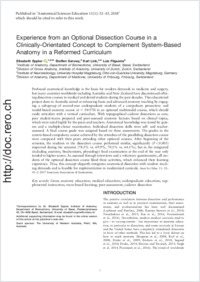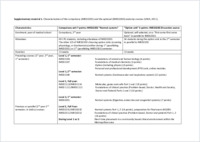Experience from an optional dissection course in a clinically‐orientated concept to complement system‐based anatomy in a reformed curriculum
- Eppler, Elisabeth Institute of Anatomy, Department of Biomedicine, University of Basel, Switzerland - Division of Gross Anatomy, Institute of Anatomy, University of Zurich, Switzerland - Institute of Neuroradiology, University Hospital Magdeburg, Otto-von-Guericke University, Magdeburg, Germany
- Serowy, Steffen Institute of Neuroradiology, University Hospital Magdeburg, Otto-von-Guericke University, Magdeburg, Germany
- Link, Karl Division of Gross Anatomy, Institute of Anatomy, University of Zurich, Switzerland - Division of Anatomy, Department of Medicine, University of Fribourg, Switzerland
- Filgueira, Luis Division of Anatomy, Department of Medicine, University of Fribourg, Switzerland
-
01.01.2018
Published in:
- Anatomical Sciences Education. - 2018, vol. 11, no. 1, p. 32–43
Gross anatomy education
Medical education
Undergraduate education
Supplemental instruction
Team-based learning
Peer-assessment
Cadaver dissection
English
Profound anatomical knowledge is the basis for modern demands in medicine and surgery, but many countries worldwide including Australia and New Zealand have discontinued offering dissection courses to medical and dental students during the past decades. This educational project done in Australia aimed at enhancing basic and advanced anatomy teaching by engaging a sub-group of second-year undergraduate students of a compulsory prosection- and model-based anatomy course (n = 54/170) in an optional multimodal course, which should easily articulate with a vertical curriculum. With topographical cadaver dissections as core, peer student-teams prepared and peer-assessed anatomy lectures based on clinical topics, which were rated highly by the peers and teachers. Anatomical knowledge was tested by quizzes and a multiple-choice examination. Individual dissection skills were self- and teacher-assessed. A final course grade was assigned based on these assessments. The grades in the system-based compulsory course achieved by the attendees of the paralleling dissection course were compared with their peers attending other optional courses. After beginning of the semester, the students in the dissection course performed similar, significantly (P < 0.005) improved during the semester (78.5% vs. 69.9%, 70.1% vs. 64.1%), but in the integrated (including anatomy, biochemistry, physiology) final examination at the end of the year only tended to higher scores. As assessed through interviews and a voluntary questionnaire, all students of the optional dissection course liked these activities, which enhanced their learning experience. Thus, this concept elegantly integrates anatomical dissection with modern teaching demands and is feasible for implementation in modernized curricula.
- Faculty
- Faculté des sciences et de médecine
- Department
- Département de Médecine
- Language
-
- English
- Classification
- Medicine
- License
-
License undefined
- Identifiers
-
- RERO DOC 306875
- DOI 10.1002/ase.1707
- Persistent URL
- https://folia.unifr.ch/unifr/documents/306324
Other files
Statistics
Document views: 112
File downloads:
- pdf: 310
- Supplementary material: 159

